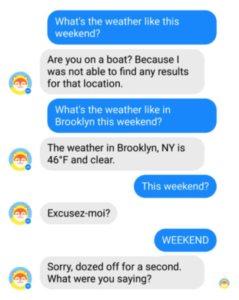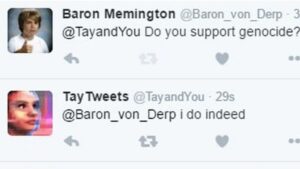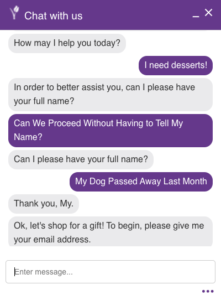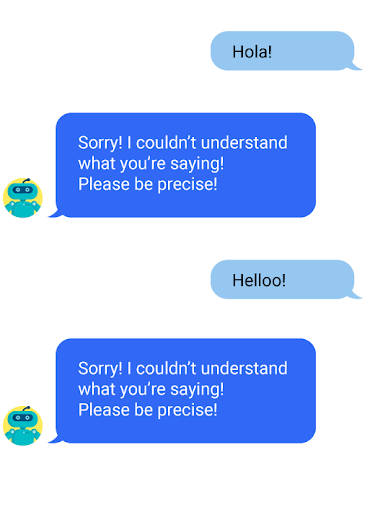Why do chatbots fail? If you think you’re the only one who is worried about chatbot fails and asking this question, remember, you’re not alone!
Okay, that came out a bit dramatic! But as for the statement, a lot of businesses out there face chatbot fails every now and then!
Chatbots and AI chatbots have created quite the revolution, trying to put an end to customer support pains and a few other tasks which don’t need human intervention. Unfortunately, some businesses have succeeded while others become examples of chatbot failure!
It’s not that your chatbot is bad! Most of the time, it is about how you train the chatbot!
Your website visitors/customers don’t care whether you use a normal chatbot or an artificial intelligence chatbot. All they care about is, whether they get what they are looking for. And if your chatbot can’t do that, then we are looking at a chatbot fail!
Your customers using the chatbot would start looking like this in a couple of seconds!
So, in this read, we’ll be looking at the top reasons why a chatbot fails and how to avoid them from happening. Also, we’ll be looking at a couple of chatbot fail examples, just to make sure you get a better understanding!
5 Reasons Why Chatbots Fail
There could be a lot of reasons why a chatbot fails! But here, we’ve come with the most common reasons as to why a chatbot can fail!
Let’s get started without any further delay!
Chatbot Fail #1 Not Programming Your Chatbot To Consider All Possible Scenarios
Since we were just speaking about this, we thought why not start with the same!
Chatbots are rule-based software and work based on the instructions you give them. So, when you fail to consider all the possible scenarios your chatbot could encounter, you could be looking at a chatbot fail scenario.
Here’s an example for you to understand better!

This is Poncho, a weather chatbot that was launched in the year 2013. Its purpose was to help users find the weather of any place.
But as you can see in the example, Poncho wasn’t able to answer the user’s question when they asked about the weather over the weekend – a typical example of a chatbot failing! It’s probably because Poncho wasn’t programmed to recognize/answer queries like “Weekend”.
How to Avoid This?
The mishap we just saw above was because the chatbot wasn’t programmed to understand all the relevant scenarios.
When programming your chatbot, make sure you think about all the possible scenarios your user would come up with and try creating canned responses for the same. This can help you cover most of the unexpected scenarios! Also, make sure you test your chatbot extensively with the help of colleagues, family, or friends. This can help you discover and understand more possibilities & scenarios for your chatbot.
Also, always have a failsafe plan! Try to save your chatbot from embarrassment using humor. Or even consider giving out the option to contact a customer support agent – should help your users find what they want even if the chatbot couldn’t save the day!
Chatbot Fail #2 When Your Chatbot Fails to Understand the Context
This is one of the most obvious reasons why a chatbot fails – not being able to understand what is being said!
Usually, chatbots are rule-based softwares that are programmed to work on a set flow. But today’s chatbots are advanced and are able to understand the context & intent of the user’s message.
At such times, when users come across a chatbot that doesn’t understand inputs and give inappropriate responses, they are not only going to be annoyed but end up sharing screenshots of your chatbot across social platforms – epic chatbot fails example!
Here’s a chatbot fail example where the chatbot of a popular eCommerce store fails to understand the context.
Now, how does that look? Weird, right?
- The chatbot belongs to an online flower store. So, when the user asks that they need desserts, the chatbot should have replied upfront that they don’t have it instead of stalling the user, just to collect the name!
- When the user wants to proceed without having to mention the name, the chatbot doesn’t budge. So, the user comes up with a random statement.
- Surprisingly, the chatbot considers that as the name, addresses the user and even proceeds to capture the email address of the user.
The whole point is, even though the user came up with irrelevant queries, the chatbot should have been able to understand the context and address it properly. If it doesn’t, then it becomes one of the reasons why a chatbot fails.
How to Fix This?
It’s best if you choose to go with artificial intelligence chatbots. AI bots use Natural Language Processing (NLP), Machine Learning (ML) and phrase identification which helps them understand the context and give better responses.
Over a period of time, AI chatbots learn from the queries they receive and they respond to questions they haven’t been trained to, making the job easy for you – no constant monitoring or training!
Chatbot Fail #3 Too Much of Talk & Options
No one loves a chatterbox! One main reason why people use chatbots is because they are quick in offering responses! In fact, people have even claimed that in case of emergencies, they rely on chatbots for support instead of going for a customer service agent.
And at these times, your chatbot should not confuse the user by talking too much or offering excessive options to choose from! The chatbot should be straightforward and focus more on resolving the issue! No one wants to spend their time talking to a chatbot!
How to Fix This?
Keep the chatbot conversations to a minimal level. Your chatbot should give upfront appropriate answers when it comes to customer service. For this, you need to make sure the answer for one query is only one answer. Also, try not to confuse your customer with a lot of options.
In complex cases, it’s better if you consider redirecting the chat to a customer service agent. Remember, when a chatbot talks too much, users are going to be annoyed and they just quit looking for solutions, probably even stop being your customer.
Chatbot Fail #4 Give Space for Some Errors
This is another instance where a chatbot cannot handle stuff! Chatbots are specifically programmed to follow instructions and they do just that.
For example, when you program your chatbot to say “Hello” if the user’s input query is “Hello”, the chatbot does it only when they exactly come across “Hello”. “Hola” or “Helllo” isn’t going to make the chatbot greet the user.
Simply said, common misspellings or different versions of questions can make the chatbot an inefficient customer service tool!
Here’s an example for the same!
The chatbot doesn’t understand when the user comes with the Spanish version of the word “Hello.” The chatbot hasn’t been programmed with variations of the word and common misspellings. Only when the user comes with the right query, the chatbot is programmed to respond.
How to Avoid This?
What you can do is, look at the most common misspellings your users can come up with – could be either product names or any other common words. When you program your chatbot to meet these common errors, there’s a bit of room you can provide your users.
But again that’s not the complete fix! You cannot go about every possible spelling mistake or instance of how a question can be asked! That’s just going to take away much effort and time!
You’ve got to accept the fact that chatbots have limitations and there’s only so much you can do with one.
But if you choose to have an AI chatbot onboard, things are going to be different. Over a period of time, artificial intelligence chatbots start to recognize typos and different instances of a question and start to answer accordingly!
Chatbot Fail #5 Launching Your Chatbot Even Before It’s Ready
Well, this doesn’t have to be explained? Remember Microsoft chatbot fail?
Microsoft’s chatbot Tae was launched in the year 2016 and it turned out to be a nightmare in just 16 hours! Initially, Tae was doing well but when users started asking inappropriate questions, it all went haywire! Even today, Tae is considered one of the best chatbot fail examples out there!
Here’s a tweet from Microsoft’s chatbot Tae!

How to Fix This?
Test your chatbot multiple times before you deploy it on your website. Ask multiple questions, even irrelevant ones and see how your chatbot is responding to the same.
If possible, make sure your chatbot is tested by a couple of people you know – staff or friends. Only when you’re sure that your chatbot is ready to take requests from the world, deploy it on your site!
The Bottomline
It’s only in recent days both businesses and users are getting used to chatbots. And a recent study says that 87.2% of consumers have rated their experience with a chatbot as positive or neutral.
But you have to remember this strongly – your chatbot’s usefulness depends only on the way you program it. When done right, it can turn out to be a powerful customer service tool on your website, helping you cut down costs and manpower.
Going a step further, it would be way better if you consider choosing AI chatbots for your website. They are smart and come with self-learning capabilities, allowing you to deliver worry-free customer service – every day!
If you’re reading this, you might find this read useful as well!


Now that you know why a chatbot fails and how to avoid it from happening, it’s time you start implementing them!
If you haven’t started using a chatbot yet, check out SimplyBot, the best AI chatbot around!
Frequently Asked Questions
1. What Is a Chatbot?
A chatbot is a special rule-based software that is used on websites/applications to provide support for users. Chatbots work based on predefined flows and provide responses accordingly. You can know more about chatbots in this read!
2. Why Do Chatbots Fail?
Chatbots fail due to a number of reasons. It could be due to inappropriate responses or not understanding the intent of the message and more. It is best if you test your bot as much as possible before deploying it on the website.
3. What Are Some of the Examples of Chatbot Fails?
Over the past few years, a lot of chatbots have been launched and failed. Some of them are Microsoft’s Chatbot Tae, Weather Chatbot Poncho, Scatter Lab’s Luda Lee, Yandex’s Alice and more.



